Deep decarbonisation pathways for Scottish industries: research report
The following report is a research piece outlining the potential pathways for decarbonisation of Scottish Industries. Two main pathways are considered, hydrogen and electrification, with both resulting in similar costs and levels of carbon reduction.
1 Executive summary
Pathways to deeply decarbonise industry and support the transition to net zero
The recent Climate Change (Emissions Reduction Targets) (Scotland) Act 2019 sets economy-wide targets for the reduction of greenhouse gas emissions to net zero by 2045 at the latest. Together with interim targets set for 2030 and 2040 mandating emission reductions of 75% and 90% against 1990 levels, respectively, this represents a divergence from the equivalent UK-wide target for 2050 and may introduce an imbalance between industries in Scotland and in the rest of the UK. Accordingly, Scotland's updated Climate Change Plan will set out actions to support achievement of the net-zero vision within the context of a Just Transition.
Work previously carried out by the Committee on Climate Change and others has shown that it would be technically feasible to meet a net-zero target in Scotland by 2045. Within this context, the Scottish Government commissioned Element Energy to assess viable pathways to deeply cut emissions from Scotland's industrial subsectors by improving energy efficiency, replacing fossil fuels with hydrogen, electricity, or in limited cases bioenergy (collectively termed 'fuel switching') and implementing carbon capture, utilisation, and storage (CCUS). This was done by assessing three pathways informed by publicly available information on industry emissions and relevant decarbonisation technologies and validating the analysis via engagement with industry stakeholders.
Emissions from industries in scope were 6.7 MtCO2e in 2018
This study focuses on emissions of carbon dioxide (CO2) from existing energy-intensive industries that are categorised as 'scope 1', i.e. occur on-site from the combustion of fossil fuels or directly from industrial processes. Specifically, emissions from industries in scope amounted to 6.7 MtCO2e in 2018, i.e. approximately 60% of all Scottish industrial emissions in the same year (11.5 MtCO2e).
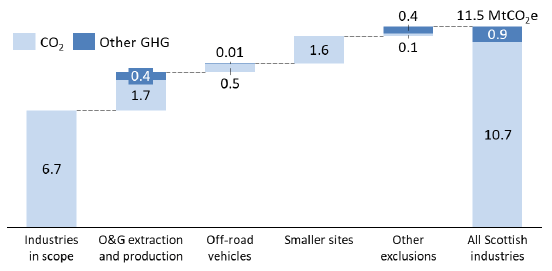
Large sites that must report their emissions yearly were responsible for 95% of the emissions in scope, with the remaining 5% arising from smaller sites that are members of the Scotch Whisky Association.
The remaining emissions are out of scope as they are from non-manufacturing industrial subsectors or from sites or sectors for which data is unavailable. A small amount of non-CO2 greenhouse gas emissions (0.02 MtCO2e) that originates from sites in scope was excluded from the scope since they represent a very small portion of the overall emissions in scope (0.3%) and the available evidence does not allow detailed assessment of the corresponding emissions sources.
Emissions are highly concentrated in 3 sectors and within 50km from Grangemouth
The industries in scope can be categorised into eight energy-intensive sectors in Scotland: chemicals, oil and gas, food and drink, cement, paper and pulp, glass, metals, and other energy-intensive industries (EIIs). Emissions are highly concentrated within a handful of sites and sectors: 75% of all emissions from the industries in scope occur within the seven highest-emitting sites which themselves are found in just three sectors (chemicals, oil and gas, and cement). Furthermore, 6 out of the 7 largest sites are located within 50 km of Grangemouth. This bears important implications for the geographical prioritisation of future decarbonisation efforts and for the corresponding infrastructure development plans.
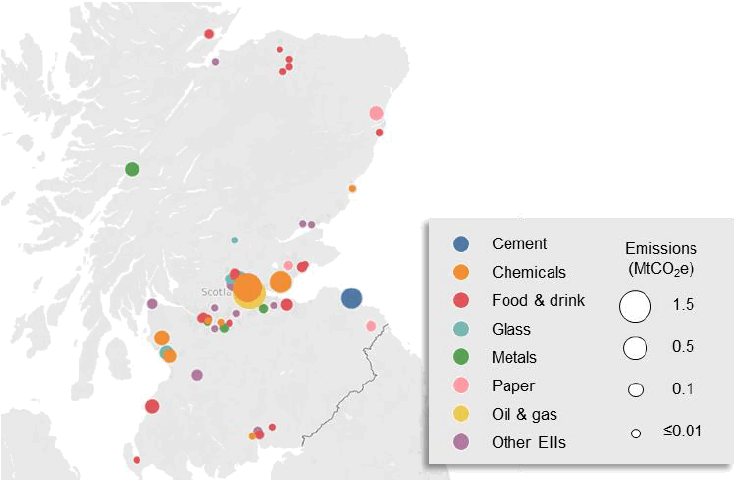
Natural gas combustion is the biggest source of emissions, followed by the use of internal fuels within the oil and gas and petrochemical industries
The combustion of purchased fossil fuels (mostly natural gas) to supply heat and power to industry isresponsible for 56% of all emissions (from industries in scope, henceforth omitted), whereas the combustion of internal fuels (i.e. industry by-products generally burned on-site and with limited or no alternative use) accounts for 30% of all emissions.
Several industrial processes emit CO2 and other greenhouse gases as a result of the chemical reactions involved in the process themselves (e.g. the cement calcination reaction), leading to process emissions which combined contribute 14% of all emissions.
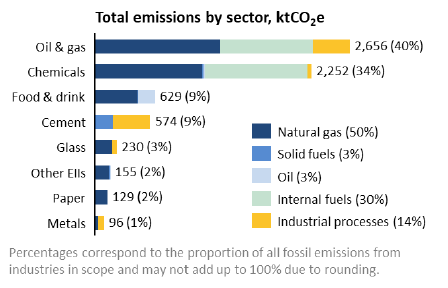
Heating processes account for nearly three quarters of all industrial emissions
Heating processes are the leading driver for industrial emissions, accounting for 74% of all emissions:
- Indirect high-temperature heating processes employed in the oil and gas and petrochemical industries are the single largest category of industrial emissions in Scotland, collectively contributing 33% of all emissions, most of which arise from internal fuel combustion.
- Indirect heating processes making use of steam are the second largest, accounting for 29% of all emissions.
- Direct heating processes are collectively responsible for 12% of all emissions, 90% of which relates to direct high-temperature processes such as furnaces and kilns.
Apart from a small portion of emissions arising from processes that could not be classified due to data limitations (2%), and process emissions (14%, already discussed above), the remaining (10%) is related to fuel combustion used to generate electricity in on-site combined heat and power (CHP) plants.
Three potential decarbonisation pathways were investigated
Three pathways were devised by combining energy efficiency measures, fuel switching, and CCUS, the last of which can be deployed to capture industrial emissions as well as those arising from the production of 'blue' hydrogen from natural gas reforming. Specifically:
- The Efficiency pathway assesses the maximum abatement that can be attained by implementing all – and only – energy efficiency measures.
- The Electrification pathway sees the electrification of all industrial processes for which it is technically viable and the deployment of CCUS on selected emissions sources not suitable for fuel switching.
- The Hydrogen pathway instead assumes that all fossil fuels are replaced by low-carbon hydrogen wherever this is technically viable. CCUS is also deployed here.
The research did not highlight any instances of fossil-fuelled appliances for which only electrification or only hydrogen fuel switching is viable, though industry stakeholders did indicate cases where one is likely to be costlier or more technically viable than the other. Hence, with the exception of the cement industry, no hydrogen is assumed to be used by industry in the Electrification pathway and no process electrification occurs in the Hydrogen pathway. In the cement industry, a mixed-fuel kiln that uses biomass, hydrogen and electricity is assumed to be used. It is also noted that hydrogen and electricity are assumed to be used to power CCUS in both pathways.
Two types of low-carbon hydrogen are considered: green hydrogen produced from the electrolysis of water powered by dedicated renewable energy sources, and blue hydrogen produced via the reforming of natural gas in combination with CCUS. In the Electrification pathway, only green hydrogen is assumed to be used. Instead, a mix of green and blue hydrogen is assumed to apply for the Hydrogen pathway, where the share of green hydrogen is assumed to grow from 10% in 2028 to 45% in 2045.
It is further assumed that neither the industrial products nor the processes used to manufacture them change over the 2020-2045 period. For this reason, the impact of demand-side measures such as product substitution, increased recycling – and more generally the transition to a circular economy – is not assessed here, although these may well have an important role to contribute in curbing industrial emissions in practice.
Emissions can be reduced by over 80% below 2018 levels by 2045
Emissions from the industries in scope are reduced by a similar amount in both the Electrification and Hydrogen pathways, collectively referred to as the deep decarbonisation pathways,reaching 1.2 MtCO2e and 1.3 MtCO2e by 2045, respectively. This represents a reduction of just over 80% from the 6.7 MtCO2e the same industries emitted in 2018.
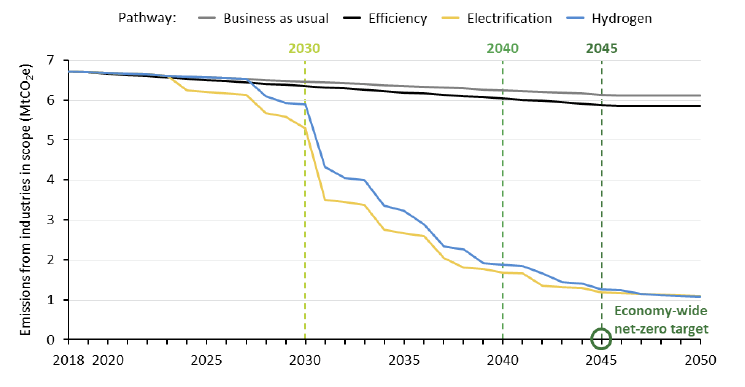
The similar decarbonisation potential of the two pathways results from the comparable feasibility and decarbonisation potential of fuel switching to electricity or hydrogen. This also implies that a hybrid pathway, where electrification occurs at certain sites and hydrogen fuel-switching at others, would be able to deliver similar emission reductions as the pathways assessed here, possibly more rapidly and cost-effectively. In the Efficiency pathway emissions in 2045 are only 12% below 2018 levels. This underlines the necessity to consider technologies able to deliver deeper emissions reductions for targeting net zero.
| Electrification | Hydrogen | |||||
|---|---|---|---|---|---|---|
| 2030 | 2040 | 2045 | 2030 | 2040 | 2045 | |
| Residual emissions (MtCO2e) | 5.3 | 1.7 | 1.2 | 5.9 | 1.9 | 1.3 |
| Net abatement vs 2018 levels | 21% | 75% | 82% | 12% | 72% | 81% |
| Cumulative abatement (MtCO2e) | 6 | 48 | 74 | 3 | 40 | 66 |
Both CCUS and fuel switching are essential for deep decarbonisation
Substantial decarbonisation occurs in all industrial sectors within both deep decarbonisation pathways. As shown in the chart below for the Electrification pathway (results for the Hydrogen pathway are shown in the appendix and are not repeated here due to their substantial similarity with the below), nearly 60% of the overall abatement occurs within the oil and gas and chemical sectors, which are the largest-emitting sectors today and are expected to remain so through to 2045.
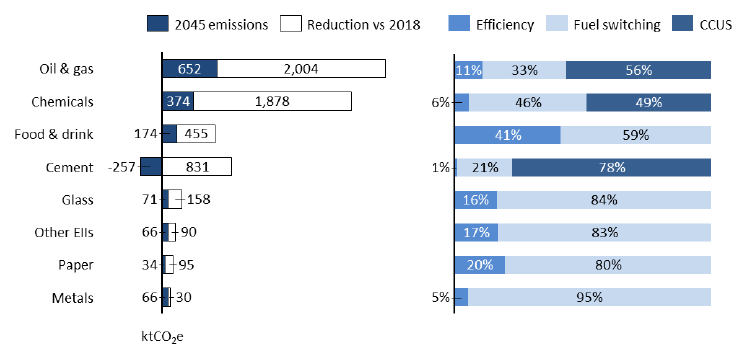
The abatement contributions of efficiency, fuel switching and CCUS to each sector's decarbonisation potential by 2045 are shown in the chart above:
- CCUS is expected to be the main decarbonisation technology for the oil and gas, chemicals, and cement sectors, delivering about 60% of the emissions abatement within these sectors. Without CCUS, emissions would be 2.7 MtCO2e higher in 2045. By combing bioenergy and CCS ('BECCS') within the cement industry nearly 0.3 MtCO2e of negative emissions are also delivered. It is noted that other industries may also deploy BECCS, though this was not assumed to happen due to the relatively small emission levels of other likely bioenergy users.
- Fuel switching accounts for about two thirds of the emission reductions in other sectors and 41% of the overall abatement. Switching fuels for steam generation should be of priority in this context, given that over 80% of the abatement from fuel switching relates to indirect heating processes using steam. It is also worth noting that CCUS could also be considered instead of fuel switching, especially for large enough emission sources, since it would deliver comparable emission reductions.
- Incremental improvements in energy efficiency offer a moderate overall contribution (11% on average) but play a more important role in certain sectors (e.g. food and drink). Also, efficiency improvements can reduce the need for expensive new infrastructure by reducing energy demand, as well as reducing energy costs.
Residual emissions
It was noted above that over 1 MtCO2e remain unabated in 2045 in the deep decarbonisation pathways. These emissions could be tackled by:
- Faster and fuller uptake of fuel switching technologies, to ensure that all processes where fossil fuels can be replaced switch before 2045, and not after.
- Increasing carbon capture rates to 95% or higher, from the 90% assumed in this study.
- Improving process reliability and hence reducing flaring in the oil and gas and chemical industries.
- CCUS and process changes to reduce residual process emissions from the oil and gas, aluminium, and glass industries.
To completely eliminate all residual emissions, a higher level of negative emissions or the substitution of carbon-intensive products with low-carbon alternatives might be necessary.
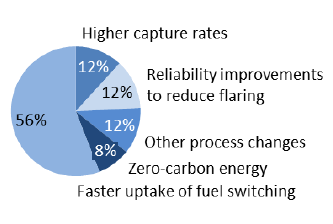
Four essential conditions to enable deep industrial decarbonisation by 2045
The achievement of the emission trajectories presented above is underpinned by the assumption that four essential conditions are met:
- Significant economic incentives must be put in place via suitable policies. Without these, no significant investment in deep decarbonisation is to be expected.
- All decarbonisation options must be adopted promptly when they become sufficiently mature from a technical and commercial point of view. This is a process which may also be brought forward with appropriate policy interventions.
- Enabling energy assets and relevant infrastructure must be deployed in advance, otherwise individual decarbonisation efforts might be delayed.
- Site managers and investors need to have sufficient confidence in, and understanding of, the relevant technologies andin the timescales for their commercialisation.
Failure to meet any of the above conditions would likely result in the delayed uptake of the key decarbonisation technologies, which may in turnmakeit even more challenging to achieve the accelerated net-zero targets.
Above all, deep decarbonisation of the industries in scope hinges on the implementation of CCUS and fuel switching at the largest emission sources (indicated in the timeline below), which would deliver two thirds of the overall abatement expected by 2045.
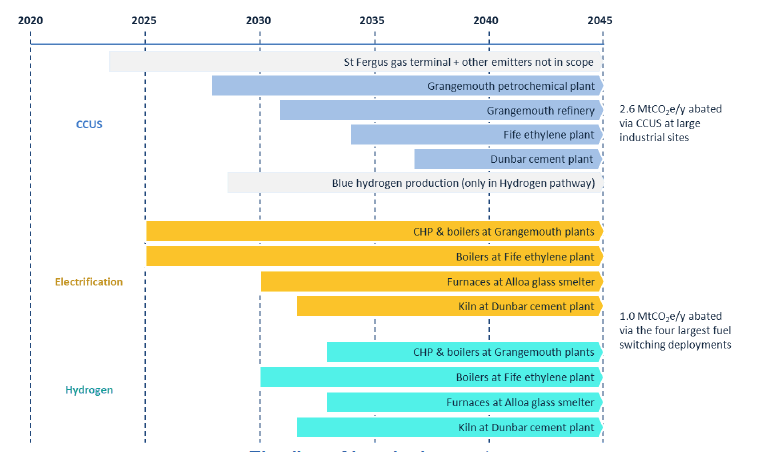
Efforts to make decarbonisation more affordable should focus on energy cost reductions
All industries in scope combined can be expected to incur additional costs of £0.8 to £1 billion per year by 2045, compared to the business-as-usual scenario where no fuel switching or CCUS are deployed. By 2045, it is estimated that this would add up to a corresponding cumulative additional cost of £11.0 billion and £11.2 billion in the Electrification and Hydrogen pathways, respectively.
The additional cost of low-carbon energy represents the greatest cost factor,due to hydrogen and electricity costing more than fossil fuels, accounting for over £6 billion over the period in both pathways. This is over 55% of the total additional cost of each pathway. Future efforts to make industrial decarbonisation more affordable should therefore focus on energy cost reductions. The total financing requirement to meet all capital expenditures until 2045 is £3.0 billion and £2.5 billion in the Electrification and Hydrogen pathways respectively.
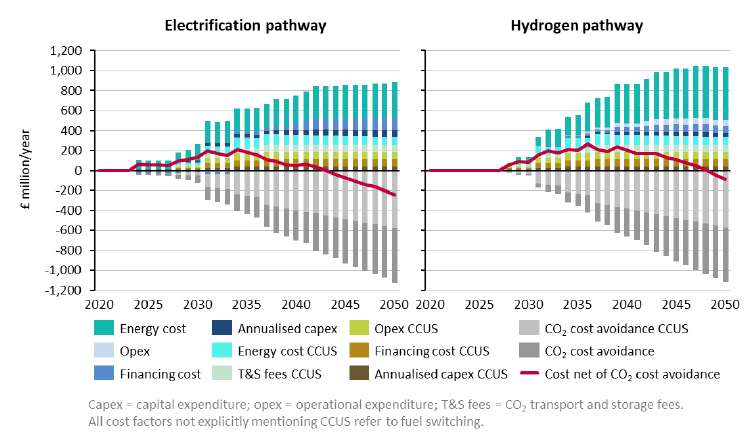
If the cost of carbon is included it could instead be cheaper to decarbonise than to continue emitting greenhouse gases in the long term. It was estimated that average carbon prices of £157/tCO2e and £188/tCO2e in the Electrification and Hydrogen pathways, respectively, could fully offset the additional cost of decarbonisation. These carbon prices correspond to the levelised cost of abatement incurred within each pathway. Finally, it was found that fuel switching contributes a higher share of the costs yet offers lower carbon savings than CCUS, which implies a correspondingly higher cost of abatement.
Policy intervention is required to stimulate investment in deep decarbonisation, prevent carbon leakage, and promote a Just Transition to net zero
Policy is widely expected to have an irreplaceable role to play in making deep industrial decarbonisation happen. Above all, the interviewed representatives from the industries in scope believed policy support to be critical for establishing a business case for investment in deep decarbonisation, while at the same time addressing the risk of carbon leakage. Without policy intervention there is a risk that a strongly increasing carbon price could affect industrial competitiveness and induce certain industrial sites to shut down. In some cases, industrial sites may relocate to regions with a lower carbon price, which would not result in any carbon abatement.
Border Carbon Adjustment Measures (BCAMs) that adjust the price of carbon-intensive imports and exports to counteract any carbon price difference between different countries might be necessary to address the risk of carbon leakage in the absence of an international agreement on the price of carbon. Should BCAMs be implemented, which would entail UK-level policy action since Scottish Ministers do not have devolved competence for trade and import/export controls, it would then be possible to further increase the carbon price to incentivise decarbonisation, though this may nonetheless fail to generate an investable business case for fuel switching and CCUS.
Policy has two broad options to help create a business case for investment in deep decarbonisation: it could offer direct financial support, for instance by subsidising the cost of low-carbon energy through a Contract for Difference mechanism (so that the cost of electricity and hydrogen would be capped to that of natural gas) and providing investment grants or low-interest loans, or it could stimulate demand for low-carbon products via demand-side measures like green procurement. This last option could prove to be lower cost, but higher levels of market disruption could result from it, since disruptive innovations may also be favoured.
In light of the Scottish Government's commitment to pursue a 'Just Transition' to net zero, it is recommended that policy consider not just the technological and economic lens presented here also the broader societal and environmental dimensions within which the transition will take place. This approach might reveal ways in which the current workforce can benefit from disruptive innovation, rather than be adversely affected by it, and may also uncover relative merits of electrification or hydrogen fuel switching when environmental impacts other than climate change are simultaneously assessed.
List of Figures
Figure 1 – Greenhouse gas emissions from Scottish industries in 2018
Figure 2 – Geographical distribution of emissions from sites in scope
Figure 3 – Historical emissions from Scottish industries
Figure 4 – Fuel combustion and process emissions by sector, 2018
Figure 6 – Emissions by cross-sectoral process
Figure 7 – Carbon intensity of the energy sources
Figure 8 – Energy price assumptions
Figure 9 – Decarbonisation options and pathways
Figure 10 – Pathway emission trajectories
Figure 11 – Sectoral contributions to overall emissions abatement (Electrification)
Figure 12 – Technology contributions to emissions abatement (Electrification)
Figure 13 – Breakdown of residual emissions (Electrification)
Figure 14 – Timeline of key deployments
Figure 15 – End use energy demand
Figure 16 – Primary energy demand
Figure 17 – Additional cost of decarbonisation
Figure 19 – Sectoral contributions to overall emissions abatement (Hydrogen)
Figure 20 – Technology contributions to emissions abatement (Hydrogen)
Figure 21 – Breakdown of residual emissions (Hydrogen)
List of Tables
Table 1 – Energy-intensive industries in scope and their subsectors
Table 2 – Direct and indirect heating processes
Table 3 – Energy efficiency measures and their abatement potential
Table 4 – Modelling assumptions on fuel-switching technologies
Table 5 – Emissions from industries in scope in 2030, 2040, and 2045
Table 6 – Emissions abatement for industries in scope in 2030, 2040, and 2045
Table 7 – Residual emissions and estimated abatement from all Scottish industries
Table 8 – Carbon capture deployments
Table 9 – Main fuel switching deployments
Table 10 – New low-carbon energy assets required
Table 11 – Breakdown of end use energy demand in 2045
Table 12 – Efficiencies and load factors of generation and conversion assets
Table 13 – Primary energy demand in 2045
Table 14 – New assets and infrastructure required by 2045
Table 15 – Breakdown of the cumulative cost of decarbonisation
Table 16 – The cost of decarbonisation net of carbon cost avoidance
Table 17 – Relative costs and benefits of fuel switching and CCUS
Table 18 – Levelised cost of abatement
Table 19 – Breakdown of Scottish GHG emissions in 2018
Table 20 – GHG emissions other than CO2
Table 21 – Sector-specific and cross-sectoral processes
Table 22 – Emissions by cross-sectoral process and sector (ktCO2e)
Table 23 – Emissions by cross-sectoral process and fuel type (ktCO2e)
Table 24 – Characteristics of emission sources where carbon capture is deployed
Table 25 – Cost assumptions for carbon capture
Table 26 – Energy requirements for carbon capture
Table 27 – Modelling parameters for CO2 compression
Acronyms
ATR Autothermal reforming
AD Anaerobic digestion
BAU Business as usual
BCAM Border Carbon Adjustment Measure
BTA Border Tax Adjustment
BECCS Bioenergy with CCS
BEIS UK Department for Business, Energy and Industrial Strategy
CAPEX Capital expenditure
CCC Committee on Climate Change
CCGT Combined cycle gas turbine
CCP Climate Change Plan
CCS Carbon capture and storage
CCUS Carbon capture, utilisation, and storage
CfD Contract for Difference
CHP Combined heat and power
CO2 Carbon dioxide
CO2e Carbon dioxide equivalent
DACCS Direct air capture and storage
EII Energy-intensive industry
ETS Emissions trading scheme
FCC Fluid catalytic cracker
GHG Greenhouse gas
H2 Hydrogen
NG Natural gas
O&G Oil and gas
OPEX Operating expenditure
SIC Standard Industrial Classification
SMR Steam methane reforming
SWA Scotch Whisky Association
T&S Transport and storage
Note on hydrogen terminology
Blue hydrogen refers to hydrogen produced from a feedstock of natural gas by steam methane reforming (SMR) or autothermal reforming (ATR) coupled with carbon capture, utilisation and storage (CCUS) of the resulting carbon dioxide emissions. Green hydrogen refers to hydrogen produced through water electrolysis using renewable electricity. Low-carbon hydrogen refers to both blue and green hydrogen. Grey hydrogen refers to hydrogen produced via SMR or ATR, but without CCUS.
Contact
Email: Michael.Cairns2@gov.scot
There is a problem
Thanks for your feedback